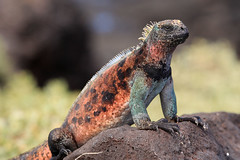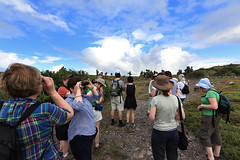 “Bread and Circuses” is another famous episode along the lines of “Patterns of Force”, a.k.a. “the Nazi episode”. This one is “the Roman episode”, complete with togas, legionaries, slavery, and gladiatorial combats.
“Bread and Circuses” is another famous episode along the lines of “Patterns of Force”, a.k.a. “the Nazi episode”. This one is “the Roman episode”, complete with togas, legionaries, slavery, and gladiatorial combats.
The Enterprise stumbles across a drifting ship near the imaginatively named planet of 892-IV. Looking for survivors, Uhura picks up signals from a native civilisation, using a primitive communication system “once called video”. This shows a Roman-styled gladiatorial fight as part of a newscast, mentioning that a barbarian named William Harris was killed in the arena. This is the name of one of the missing crew of the drifting vessel, so Kirk, Spock, and McCoy beam down to investigate. They find a civilisation based on the Roman Empire, but with 20th century level technology. Kirk refers to Hodgkin’s Law of Parallel Planet Development to explain this. The parallel is so close, they even speak colloquial 20th century English.
There is a series of misadventures as the trio are captured by a resistance group of escaped slaves, who profess a philosophy of peace and worship of the Sun. Kirk learns that the First Citizen of the Empire is named Merikus, eerily similar to Captain Merik of the abandoned ship. He asks for the slaves’ help to talk to Merikus and find out what has happened. The Prime Directive is quoted. Escaped gladiator Flavius Maximus, at first sceptical of them, helps them to find Merikus.
They all get captured and forced to fight in the arena, Spock and McCoy against Flavius and an unnamed gladiator. This gives a sterling opportunity for Spock and McCoy to engage in friendly but intense antagonistic banter as they flail ineffectively with their cardboard swords. Spock uses his Vulcan nerve pinch to win and they are thrown back in cells. Kirk, meanwhile, is wooed by the Proconsul Claudius Marcus, who Merik has informed about the true origins of himself and Kirk. Claudius wants the Enterprise crew to beam down to fight in the games. When Kirk refuses, Claudius leaves him alone with his slave girl Drusilla, in a revealing silver outfit. Back in their cells, McCoy tells Spock he is “worried about Jim too,” followed by a cut to Kirk kissing Drusilla, and then a James-Bond-dissolve to Kirk waking up on a bed.
Despite this, Kirk refuses Claudius’s demand again, and Claudius orders him executed live on TV. Meanwhile, Scotty, on board the Enterprise, chooses this exact moment to disrupt the city’s power supply from orbit, resulting in chaos. Flavius intervenes to save Kirk and is shot for his trouble. Out of the blue and for some unexplained reason, Merik then radios the Enterprise and instructs them to beam up three people, then tosses the communicator to Kirk as Claudius stabs him. Kirk, Spock, and McCoy escape as guards fire machine guns at their fading bodies. Back on board the Enterprise, Spock is mystified by why the slaves worship the Sun, as there were no Sun worshippers in Rome. Uhura says she had been monitoring radio messages which made it clear it wasn’t the “Sun in the sky”, but the “Son of God” they were talking about. This is actually a clever bit of plotting and misdirection, though it is spoilt by the subsequent preachy nature of the end-of-story moral.
Also, there is never any explanation of how Merik managed to become First Citizen of the entire Empire. Even a throwaway line about his superior technology or something would have helped, but the question isn’t even raised. And there’s some notable weird coloured lighting in the prison cells again – the back walls are obviously illuminated by red spotlights for some reason. The season 2 lighting director must have loved coloured spotlights. Overall, a slightly below average episode. It’s a bit hokey, but the plot and action are passable, if you can get over the whole Space Romans thing.
Tropes: Bread And Circuses, Planet Of Hats, Space Romans, Inexplicable Cultural Ties, Alien Non-Interference Clause, Involuntary Battle To The Death, Gladiator Games, Flynning, Grudging Thank You, Think Nothing Of It, Theiss Titillation Theory, Sexy Discretion Shot, Thirty Second Blackout, Shoot Out The Lock.
Body count: William B. Harris (gladiatored to death pre-credits, reported as news), Flavius Maximus (shot by guards), Captain Merik (stabbed by Claudius).



 My first professional academic publication in 16 years:
My first professional academic publication in 16 years: Ah, “
Ah, “ “
“

